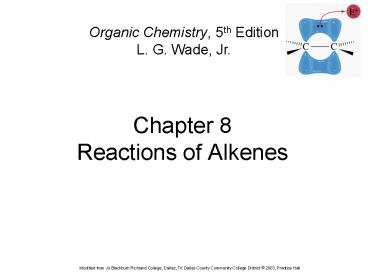Chapter 8 Reactions of Alkenes
1 / 43
Title:
Chapter 8 Reactions of Alkenes
Description:
Protonation of double bond yields the most stable carbocation. ... Borane prefers least-substituted carbon due to steric hindrance as well as charge distribution. ... –
Number of Views:118
Avg rating:3.0/5.0
Title: Chapter 8 Reactions of Alkenes
1
Chapter 8Reactions of Alkenes
Organic Chemistry, 5th EditionL. G. Wade, Jr.
Modified from Jo Blackburn Richland College,
Dallas, TX Dallas County Community College
District ã 2003, Prentice Hall
2
(No Transcript)
3
(No Transcript)
4
(No Transcript)
5
See the movie
6
Types of Additions
gt
7
(No Transcript)
8
Addition of HX
- Protonation of double bond yields the most stable
carbocation. Positive charge goes to the carbon
that was not protonated.
9
(No Transcript)
10
(No Transcript)
11
Markovnikovs Rule
- Highly endergonic first step (rate determining)
and a highly exergonic second step
12
Markovnikovs Rule
- The product with the more stable carbocation
intermediate favored - The most stable carbocation has a lower DG
- Carbocation-like transition state stabilized
13
(No Transcript)
14
(No Transcript)
15
(No Transcript)
16
(No Transcript)
17
In an electrophilic addition to an alkene, the
electrophile adds in such a way as to form the
most stable intermediate.
18
(No Transcript)
19
Anti-Markovnikov ??
X
- Tertiary radical is more stable, so that
intermediate forms faster. gt
20
(No Transcript)
21
(No Transcript)
22
(No Transcript)
23
(No Transcript)
24
(No Transcript)
25
(No Transcript)
26
Hydration of Alkenes
- Reverse of dehydration of alcohol
- Use very dilute solutions of H2SO4 or H3PO4 to
drive equilibrium toward hydration.
gt
27
(No Transcript)
28
(No Transcript)
29
(No Transcript)
30
(No Transcript)
31
Indirect Hydration
- Oxymercuration-Demercuration and
Alkoxymercuration-Demercuration - Markovnikov product formed
- Anti addition of H-OH
- No rearrangements
- Hydroboration
- Anti-Markovnikov product formed
- Syn addition of H-OH
gt
32
Oxymercuration (1)
- Reagent is mercury(II) acetate which dissociates
slightly to form Hg(OAc). - Hg(OAc) is the electrophile that attacks the pi
bond.
33
Oxymercuration (2)
- The intermediate is a cyclic mercurinium ion, a
three-membered ring with a positive charge.
gt
34
Oxymercuration (3)
- Water approaches the mercurinium ion from the
side opposite the ring (anti addition). - Water adds to the more substituted carbon to form
the Markovnikov product.
AcOH AcO- H3O
35
Demercuration
- Sodium borohydride, a reducing agent, replaces
the mercury with hydrogen.
36
Predict the Product
- Predict the product when the given alkene reacts
with aqueous mercuric acetate, followed by
reduction with sodium borohydride.
37
Alkoxymercuration - Demercuration
- If the nucleophile is an alcohol, ROH, instead of
water, HOH, the product is an ether.
38
Hydroboration
- Borane, BH3, adds a hydrogen to the most
substituted carbon in the double bond. - The alkylborane is then oxidized to the alcohol
which is the anti-Mark product.
39
Borane Reagent
- Borane exists as a dimer, B2H6, in equilibrium
with its monomer. - Borane is a toxic, flammable, explosive gas.
- Safe when complexed with tetrahydrofuran.
40
Mechanism
- The electron-deficient borane adds to the
least-substituted carbon. - The other carbon acquires a positive charge.
- H adds to adjacent C on same side (syn).
41
Actually, Trialkyl
- Borane prefers least-substituted carbon due to
steric hindrance as well as charge distribution.
gt
42
Oxidation to Alcohol
- Oxidation of the alkyl borane with basic hydrogen
peroxide produces the alcohol. - Orientation is anti-Markovnikov.
43
Predict the Product
Predict the product when the given alkene reacts
with borane in THF, followed by oxidation with
basic hydrogen peroxide.































